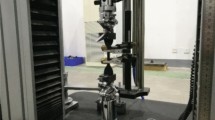Abstract
Fatigue life prediction is very important for the reliability and safety design of rubber isolators. As there is still no precise and credible theoretical or simulation method on fatigue life prediction for the kind of rubber isolators whose shape may change with time during the whole useful life, it means that the experimental method is still the best solution for the problem. A force-controlled temperature-accelerated fatigue experiment is designed for these long-life rubber isolators. The experiment introduced essential factors such as the equipment demands, stress condition, data collection and data processing. Compared with the traditional way, there are four advantages of the new experiment: the time cost of the experiment, the authenticity of the experiment data, the quantity of valid data and the control method of the mechanical load. By calculating the real-time vertical displacement, global stiffness and dissipated energy of the tested sample, the new experiment can improve the quantity of valid data for further researches. Moreover, Arrhenius model is proved accurately to estimate the accelerated life.






Similar content being viewed by others
References
Q. Li, J. Zhao, B. Zhao, Fatigue life prediction of a rubber mount based on test of material properties and finite element analysis. Eng. Fail. Anal. 16(7), 2304–2310 (2009)
R.J. Harbour, A. Fatemi, W.V. Mars, Fatigue life analysis and predictions for NR and SBR under variable amplitude and multiaxial loading conditions. Int. J. Fatigue 30(7), 1231–1247 (2008)
W.V. Mars, A. Fatemi, A literature survey on fatigue analysis approaches for rubber. Int. J. Fatigue 24(9), 949–961 (2002)
C. Woo, W. Kim, J. Kwon, A study on the material properties and fatigue life prediction of natural rubber component. Mater. Sci. Eng. A 483(1), 376–381 (2008)
C.S. Woo, H.S. Park, Useful lifetime prediction of rubber component. Eng. Fail. Anal. 18(7), 1645–1651 (2011)
A. Andriyana, N. Saintier, E. Verron, Configurational mechanics and critical plane approach concept and application to fatigue failure analysis of rubberlike materials. Int. J. Fatigue 32(10), 1627–1638 (2010)
J. Grandcoin, A. Boukamel, S. Lejeunes, A micro mechanically based continuum damage model for fatigue life prediction of filled rubbers. Int. J. Solids Struct. 51(6), 1274–1286 (2014)
C. Woo, W. Kim, S. Lee et al., Fatigue life prediction of vulcanized natural rubber subjected to heat aging. Proc. Eng. 1(1), 9–12 (2009)
M. Flamma, J. Spreckels, T. Steinweger et al., Effects of very high loads on fatigue life of NR elastomer materials. Int. J. Fatigue 33(9), 1189–1198 (2011)
N. Saintier, G. Cailletaud, R. Piques, Multiaxial fatigue life prediction for a natural rubber. Int. J. Fatigue 28(5–6), 530–539 (2011)
Author information
Authors and Affiliations
Corresponding author
Rights and permissions
About this article
Cite this article
Jin, Z., He, L. & Zhao, Yl. Fatigue Life Prediction of Rubber Isolator Based on Force-Controlled Temperature-Accelerated Fatigue Experiment. J Fail. Anal. and Preven. 17, 774–779 (2017). https://doi.org/10.1007/s11668-017-0303-6
Received:
Published:
Issue Date:
DOI: https://doi.org/10.1007/s11668-017-0303-6




